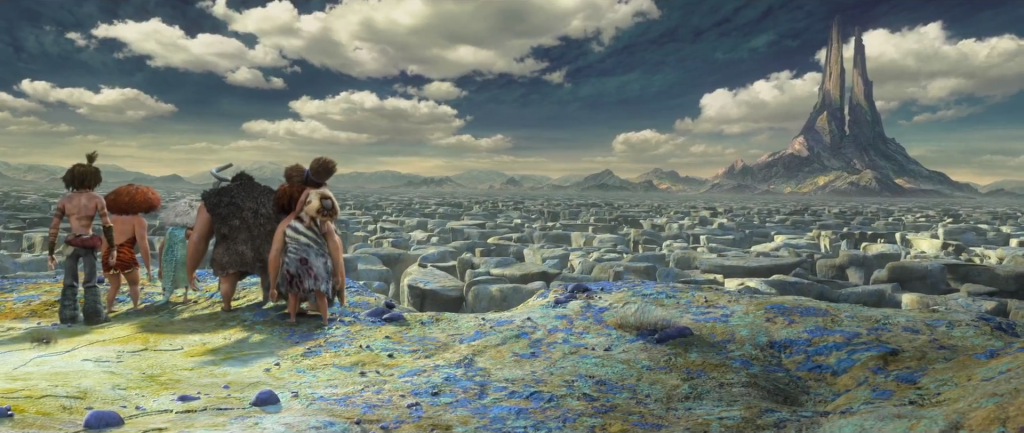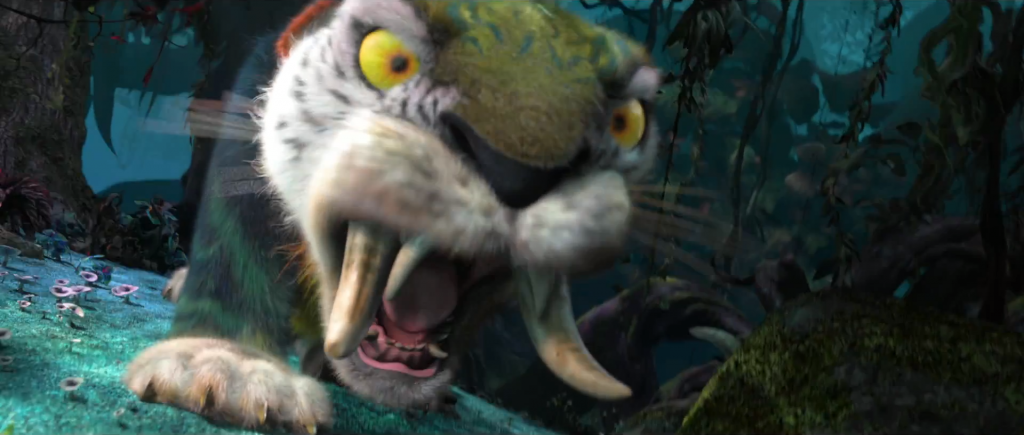Croodly Stated
On March 12th, “The Croods” screened at the Union Square Regal Cinemas. John Canemaker hosted a Q&A with directors Kirk De Micco & Chris Sanders. It was a rather special evening for NYU students and alumni. Mr. Canemaker (an NYU professor and Academy Award winner) orchestrated the affair mainly so that his students could benefit from the experiences of two great movie-makers. If you attended NYU for animation, you are familiar with the Student Animation League, and probably took advantage of their frequent panels, pizza parties, and relaxing movie nights. If they hadn’t changed the NYU ID cards, I’d probably still go myself.
John Canemaker is a great historian, and his interview revealed the very interesting story of how “The Croods” was made. For those who don’t know, or didn’t click on the link to the trailer above, “The Croods” is about a family of cave-people who are forced from their home by a natural disaster, and road trip across the land to their destiny. The earliest version of the movie could be found with Kirk De Micco and John Cleese. They had previously been fiddling with a Roald Dahl adaptation, but decided to create a cave-man story. It was about two colonies, (“The Croods” vs “The Flash”) one backwards and the other brash, competing, and probably was a loose metaphor of the English and the French. But the idea stalled, and it wasn’t until after Chris Sanders came back from “How To Train Your Dragon” that Kirk pitched the idea of “the one family.” A rather unconventional family at that. Chris Sanders said that ‘writing a feature is like building an airplane.’ The two directors said that it was a new challenge for them. Even though it seemed like the movie had a small group of characters (Sandy, Ugga, Eep, Grug, Guy, Gran, and Thunk) they were almost always all on the screen together.
Besides discussing the story process, Kirk and Chris gave their own backstories, to the crowd of eager students. Kirk De Micco hinted at some exciting story involving following a girl to Italy, but I found it more interesting when he discussed his first job prospects in New York. He wanted to pursue a writing career, (one way into the movie business is to write your way in, he said) and the choice he had at the time was between Harvey Weinstein and the William-Morris Agency. He took the job at WMA because he felt it gave him more freedom (he was a mail clerk), and, very importantly, access to over 1,000 scripts. “You couldn’t imagine,” he told us, ‘how valuable that was in the pre-internet era of 1994.’
Chris Sanders discussed his application process to CAL Arts, and described it as a time when they were trying to replace retiring animators. He went to school with Kelly Asbury and Rob Minkoff. Later on, as he was describing his early career, he said that in animation ‘the development department was new.’ He didn’t know what it was, and the people interviewing him didn’t have a clear idea either. So, through charisma and confidence, it seems like he carried it off and invented the job for himself. When they asked him to draw storyboards, he initially refused, because he thought he was unprepared. But they liked his concept art so much, that they kept asking him to fill in more drawings of diff scenes, so that in no time, he was essentially drawing and pitching a normal storyboard. He stressed that one of the first things he had to teach himself on the job was how to draw on demand. [Coincidentally, this is not a problem I think any of my classmates ever had. Maybe they didn’t have Moleskins back in Chris’ day].
The conversation soon turned back to “The Croods.” The directors were interested in the parent’s fear of their child growing away. “The Croods” also turned into a road-trip movie, since there was no traditional villain, just a traditional family. At one point in the film, the characters are confronted by a giant rock maze. In initial drafts the maze was a background for fun gags about magnetic rocks, but the idea was scrapped. They only brought it back into the story once it became clear that the maze could serve as a literal and metaphorical divisive element. Chris and Kirk agreed that from almost the very beginning, the movie centered around the END. I won’t spoil it, but the idea of fight or flight for the father was always very integral to the conversation. They spent just two days talking about whether or not the father would die.
As the Croods race across the land, they are stalked by a giant kitty. It was the only creature designed by Chris himself (there are many fantastical, almost real, prehistoric animals in the movie). The kitty was born out of a nameless foe that pursued the family in the original story sketches. But it was soon developed into a real character, as a foil to the faceless, ever changing threat of earthquakes. I asked about the kitty because I was impressed by one of his first scenes where his already giant head fills the frame. I love it when the character design only serves to further emphasize the characters actions. Chris told me that the kitty is literally an impossible creature. He wouldn’t allow the modelers to shrink the head, despite legitimate protests that the rig wouldn’t work. And in fact, if you rotated the camera, in many scenes you would see the paws are separate from the body. Brilliant! This is what animation is all about.
The directors also talked about Roger Deakins, and his excellent work on lighting. The key is not to overlight it. Even though you spent a hideous amount of money and time modeling an amazing set, it’s ok to light the scene so that you don’t see everything. It’s all about paring lights back. One thing Roger did enjoy about lighting animation movies (like “How To Train Your Dragon”) was that you could set a light in the middle of the characters without actually showing the light source itself.
Finally, John Canemaker asked Chris and Kirk if they could give advice to the students, some of which were about to enter the job market and leave the nest. Chris told us to ask ourselves ‘just how serious it that note about the story really’ and that sometimes you can just ignore it. Eventually, the element in question can work itself naturally into the film after repeated drafts. He also advised that before showing a film, to let your audience know what it is your trying to do, and then after they watch it, they can tell if you that is what they actually saw. (I don’t know how I feel about that, I was raised to “show not tell.”) Kirk said that businesses are fickle things: one day the studio you are working at is there, the next it is not. One of these guys said that it is important for you to hold on to the first job you get, because even if you have a certain idea of what you want your career to be, you never know what new things you might learn or what new people you might meet. Chris’ last advice was to find people in the industry who can do “it” and can do “it” really well. That certainly seems to be the case with crew of “The Croods.”
“The Croods” is in theatres now.








